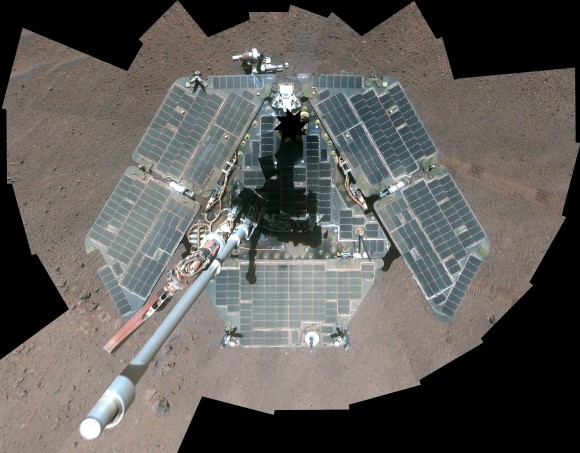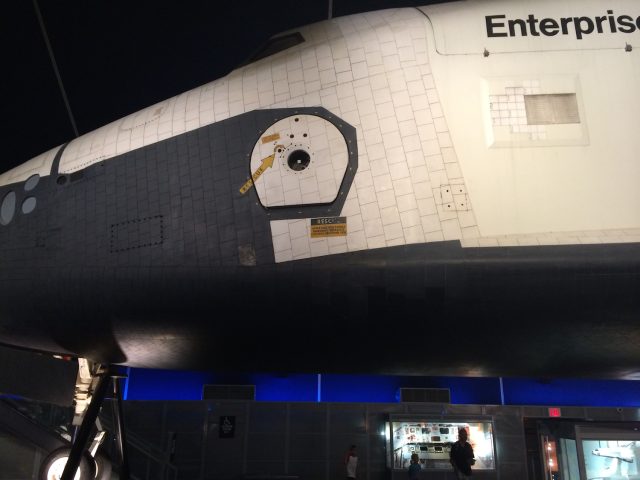| |

| Author |
Topic Options
|

 Posts:
Posts: 51973
 Posted: Posted: Mon Sep 15, 2014 8:16 am
$1: Curiosity Arrives at Mount SharpCuriosity reaches Mt. Sharp, the rover mission's long-term prime destination! NASA's Mars Curiosity rover has reached the Red Planet's Mount Sharp, a Mount-Rainier-size mountain at the center of the vast Gale Crater and the rover mission's long-term prime destination. "Curiosity now will begin a new chapter from an already outstanding introduction to the world," said Jim Green, director of NASA's Planetary Science Division at NASA Headquarters in Washington. "After a historic and innovative landing along with its successful science discoveries, the scientific sequel is upon us." Curiosity's trek up the mountain will begin with an examination of the mountain's lower slopes. The rover is starting this process at an entry point near an outcrop called Pahrump Hills, rather than continuing on to the previously-planned, further entry point known as Murray Buttes. Both entry points lay along a boundary where the southern base layer of the mountain meets crater-floor deposits washed down from the crater's northern rim. "It has been a long but historic journey to this Martian mountain," said Curiosity Project Scientist John Grotzinger of the California Institute of Technology in Pasadena. "The nature of the terrain at Pahrump Hills and just beyond it is a better place than Murray Buttes to learn about the significance of this contact. The exposures at the contact are better due to greater topographic relief." The decision to head uphill sooner, instead of continuing to Murray Buttes, also draws from improved understanding of the region's geography provided by the rover's examinations of several outcrops during the past year. Curiosity currently is positioned at the base of the mountain along a pale, distinctive geological feature called the Murray formation. Compared to neighboring crater-floor terrain, the rock of the Murray formation is softer and does not preserve impact scars, as well. As viewed from orbit, it is not as well-layered as other units at the base of Mount Sharp.  http://mars.jpl.nasa.gov/msl/news/whats ... ewsID=1705
|

 Posts:
Posts: 51973
 Posted: Posted: Mon Sep 15, 2014 8:18 am
$1: Martian Ctl-Alt-Del: NASA Resets Opportunity Rover’s Memory, Stopping The Science HiatusIn fantastic news for the long-running Opportunity mission on Mars, NASA says the rover’s much-needed memory reset worked out perfectly. The rover was unable to perform science or beam pictures back to Earth because portions of its flash memory — which can store information even when the rover is turned off — were beginning to wear out. The reboot means the rover is soon going to be on the move again as it continues exploring the rim of Endeavour Crater, tacking on nearly a marathon of miles that Opportunity has racked up on Mars since 2004. “The rover’s Flash file system was successfully reformatted on Sol 3773 (Sept. 4, 2014),” NASA wrote in an update on the Mars Exploration Rover website late last week. “The Flash space available is slightly smaller (<1%) than before the reformat, consistent with the reformatting process flagging some bad cells to avoid.”   http://www.universetoday.com/114564/mar ... ce-hiatus/
|

 Posts:
Posts: 51973
 Posted: Posted: Mon Sep 15, 2014 8:20 am
$1: A closer look at the space shuttle that never got to spaceNEW YORK—The space shuttle Enterprise has been ensconced aboard the USS Intrepid for just over two years. It sits in a silent warehouse, dramatically lit so it appears to be cruising in a dark vacuum. Tourists can wander around or under it at the exhibit; they can even walk up some stairs and get nose-to-nose with the Enterprise, staring down its long axis through a thick layer of glass. While the whole thing evokes space exploration, the Enterprise has never actually made it out of Earth's atmosphere. The shuttle on display has the distinction of being one of NASA's biggest workhorses despite earning perhaps the least amount of glory among the entire space shuttle fleet. So while visitors look closely at the Enterprise, they can see what has stopped it from earning more prestige and examine the scars its body has retained from experimentation during its years in service from 1976 through 2012. Like the USS Enterprise it's named after, the Enterprise shuttle is more or less fake. Where a shuttle's $40 million engines should be, the Enterprise has mere mockups, covered by a cone for aerodynamic purposes. A shuttle should be speckled with reaction control system thrusters to help maintain or change its orientation in space. But since the Enterprise has always been Earth-bound, it has nothing but covered holes. The shuttle's skin is also not space-ready. Eventually, NASA figured out that the best dorsal surface material for shuttles entering and leaving space was a variety of blankets, some made from Nomex felt and others from quilted surface material. The Enterprise's skin is more like that of a plane, with polyurethane foam tiles to simulate the surface of actual shuttles. It uses fiberglass tiles on the leading-edge panels where the shuttle gets the hottest on re-entry instead of the reinforced carbon-carbon required to withstand 2,300ºF temperatures.   http://arstechnica.com/science/2014/09/ ... -to-space/
|

 Posts:
Posts: 51973
 Posted: Posted: Mon Sep 15, 2014 8:22 am
$1: Rosetta: Audacious comet landing site chosen"J" marks the spot for Rosetta's robot landing craft Philae Scientists and engineers have spent weeks studying the 4km-wide "ice mountain" known as 67P, looking for a location they can place a small robot. They have chosen what they hope is a relatively smooth region on the smaller of the comet's two lobes. But the team is under no illusions as to how difficult the task will be. Comet 67P/Churyumov-Gerasimenko, currently sweeping through space some 440 million km from Earth, is highly irregular in shape. Its surface terrain is marked by deep depressions and towering cliffs. Even the apparently flat surfaces contain potentially hazardous boulders and fractures. Avoiding all of these dangers will require a good slice of luck as well as careful planning. Pre-mission analysis suggested the chances of a successful landing on roughly spherical body to be 70-75%. With 67P's rubber duck shape, those odds have surely lengthened, but European Space Agency (Esa) project manager Fred Jansen is excited at the prospect of trying. "At the end of the day, you'll only know when you land. Then it will have been either 100% or zero. That's the way it is," he told BBC News.   http://www.bbc.com/news/science-environment-29203284
|

 Posts:
Posts: 51973
 Posted: Posted: Tue Sep 16, 2014 10:17 am
$1: The little-known Soviet mission to rescue a dead space station$1: The following story happened in 1985 but subsequently vanished into obscurity. Over the years, many details have been twisted, others created. Even the original storytellers got some things just plain wrong. After extensive research, writer Nickolai Belakovski is able to present, for the first time to an English-speaking audience, the complete story of Soyuz T-13’s mission to save Salyut 7, a fascinating piece of in-space repair history. It’s getting dark, and Vladimir Dzhanibekov is cold. He has a flashlight, but no gloves. Gloves make it difficult to work, and he needs to work quickly. His hands are freezing, but it doesn’t matter. His crew’s water supplies are limited, and if they don’t fix the station in time to thaw out its water supply, they’ll have to abandon it and go home, but the station is too important to let that happen. Quickly, the sun sets. Working with the flashlight by himself is cumbersome, so Dzhanibekov returns to the ship that brought them to the station to warm up and wait for the station to complete its pass around the night side of the Earth. He’s trying to rescue Salyut 7, the latest in a series of troubled yet increasingly successful Soviet space stations. Its predecessor, Salyut 6, finally returned the title of longest manned space mission to the Soviets, breaking the 84-day record set by Americans on Skylab in 1974 by 10 days. A later mission extended that record to 185 days. After Salyut 7’s launch into orbit in April 1982, the first mission to the new station further extended that record to 211 days. The station was enjoying a relatively trouble-free start to life. However, this was not to last. On February 11, 1985, while Salyut 7 was in orbit on autopilot awaiting its next crew, mission control (TsUP) noticed something was off. Station telemetry reported that there had been a surge of current in the electrical system, which led to the tripping of overcurrent protection and the shutdown of the primary radio transmitter circuits. The backup radio transmitters had been automatically activated, and as such there was no immediate threat to the station. Mission controllers, very tired now that the end of their 24-hour shift was approaching, made a note to call specialists from the design bureaus for the radio and electrical systems. The specialists would analyze the situation, and produce a report and recommendation, but for now the station was fine, and the next shift was ready to come on duty. Without waiting for the specialists to arrive, or perhaps not bothering to call them in the first place, the controllers on the next shift decided to reactivate the primary radio transmitter. Perhaps the overcurrent protection had been tripped accidentally, and if not, then it should still be functional and should still activate if there really was a problem. The controllers, acting against established tradition and procedures of their office, sent the command to reactivate the primary radio transmitter. Instantly, a cascade of electrical shorts swept through the station, and knocked out not only the radio transmitters, but also the receivers. At 1:20pm and 51 seconds on February 11, 1985, Salyut 7 fell silent and unresponsive. . . . The first crew to launch to Mir did something unprecedented. After arriving at Mir and performing initial operations to bring the new station online, they boarded their Soyuz and flew to Salyut 7, the first and, to date, only time in history a station-to-station crew transfer had taken place. They completed the work left behind by the Soyuz T-14 crew, after which they returned to Mir before eventually returning to Earth.   http://arstechnica.com/science/2014/09/ ... e-station/
|

 Posts:
Posts: 51973
 Posted: Posted: Tue Sep 16, 2014 1:10 pm
$1: Astronomers Found a Star Inside a Star, 40 Years After It Was First TheorizedThe universe is massive, and we can’t see nearly all of it. That's the most exciting thing about space: The potential to find something completely unknown, something that brings fiction into fact, is ever-present. Case in point: A rather strange celestial body called a Thorne–Żytkow object (TZO). Originally predicted in the 1970s, the first non-theoretical TZO was likely found earlier this year, based on calculations presented in a paper forthcoming in MNRAS. TZOs were predicted by astronomer Kip Thorne and Anna Żytkow, who was then postdoctoral fellow at CalTech. The pair imagined what might happen if a neutron star in a binary system merged with its partner red supergiant. This wouldn’t be like two average stars merging. Neutron stars are the ancient remnants of stars that grew too big and exploded. Their cores remain small—about 12.5 miles—as they shed material out into space. Red supergiants are the largest stars in the galaxy with radii up to 800 times that of our sun, but they aren’t dense. So what would it look like for a massive star to merge with the tiny, super-dense core of another? This merger would create a system where a neutron star surrounded by a diffuse envelope of material would look almost identical to a regular red supergiant. But inside, most of the system’s energy still comes from the star’s core.  http://motherboard.vice.com/read/astron ... -theorized
|

 Posts:
Posts: 51973
 Posted: Posted: Thu Sep 18, 2014 7:06 am
|

 Posts:
Posts: 14139
 Posted: Posted: Thu Sep 18, 2014 10:42 am
Absolutely stunning photos in that link 
|

 Posts:
Posts: 51973
 Posted: Posted: Thu Sep 25, 2014 7:21 am
$1: NASA Telescopes Find Clear Skies and Water Vapor on ExoplanetAstronomers using data from three of NASA's space telescopes -- Hubble, Spitzer and Kepler -- have discovered clear skies and steamy water vapor on a gaseous planet outside our solar system. The planet is about the size of Neptune, making it the smallest planet from which molecules of any kind have been detected. "This discovery is a significant milepost on the road to eventually analyzing the atmospheric composition of smaller, rocky planets more like Earth," said John Grunsfeld, assistant administrator of NASA's Science Mission Directorate. "Such achievements are only possible today with the combined capabilities of these unique and powerful observatories." Clouds in a planet's atmosphere can block the view to underlying molecules that reveal information about the planet's composition and history. Finding clear skies on a Neptune-size planet is a good sign that smaller planets might have similarly good visibility. "When astronomers go observing at night with telescopes, they say 'clear skies' to mean good luck," said Jonathan Fraine of the University of Maryland, College Park, lead author of a new study appearing in Nature. "In this case, we found clear skies on a distant planet. That's lucky for us because it means clouds didn't block our view of water molecules." The planet, HAT-P-11b, is categorized as an exo-Neptune -- a Neptune-sized planet that orbits the star HAT-P-11. It is located 120 light-years away in the constellation Cygnus. This planet orbits closer to its star than does our Neptune to our sun, making one lap roughly every five days. It is a warm world thought to have a rocky core and gaseous atmosphere. Not much else was known about the composition of the planet, or other exo-Neptunes like it, until now.  http://www.jpl.nasa.gov/news/news.php?release=2014-322
|

 Posts:
Posts: 51973
 Posted: Posted: Mon Sep 29, 2014 11:11 am
$1: . Astronomy Photo of the Day (APotD): 9/29/14 — The Calm Before The StormWhen this image was released by the European Southern Observatory (ESO), they described this tranquil scene as “the calm before the storm:” a description that couldn’t possibly be more apt. As picturesque as these galaxies are in their present form, soon, both will be twisted and deformed into something unrecognizable, yet still beautiful in their own way. 
|

 Posts:
Posts: 51973
 Posted: Posted: Tue Sep 30, 2014 7:49 am
$1: Cassini Watches Mysterious Feature Evolve in Titan SeaNASA's Cassini spacecraft is monitoring the evolution of a mysterious feature in a large hydrocarbon sea on Saturn's moon Titan. The feature covers an area of about 100 square miles (260 square kilometers) in Ligeia Mare, one of the largest seas on Titan. It has now been observed twice by Cassini's radar experiment, but its appearance changed between the two apparitions. Images of the feature taken during the Cassini flybys are available at: http://photojournal.jpl.nasa.gov/catalog/PIA18430The mysterious feature, which appears bright in radar images against the dark background of the liquid sea, was first spotted during Cassini's July 2013 Titan flyby. Previous observations showed no sign of bright features in that part of Ligeia Mare. Scientists were perplexed to find the feature had vanished when they looked again, over several months, with low-resolution radar and Cassini's infrared imager. This led some team members to suggest it might have been a transient feature. But during Cassini's flyby on August 21, 2014, the feature was again visible, and its appearance had changed during the 11 months since it was last seen. Scientists on the radar team are confident that the feature is not an artifact, or flaw, in their data, which would have been one of the simplest explanations. They also do not see evidence that its appearance results from evaporation in the sea, as the overall shoreline of Ligeia Mare has not changed noticeably. The team has suggested the feature could be surface waves, rising bubbles, floating solids, solids suspended just below the surface, or perhaps something more exotic. The researchers suspect that the appearance of this feature could be related to changing seasons on Titan, as summer draws near in the moon's northern hemisphere. Monitoring such changes is a major goal for Cassini's current extended mission. "Science loves a mystery, and with this enigmatic feature, we have a thrilling example of ongoing change on Titan," said Stephen Wall, the deputy team lead of Cassini's radar team, based at NASA's Jet Propulsion Laboratory in Pasadena, California. "We're hopeful that we'll be able to continue watching the changes unfold and gain insights about what's going on in that alien sea."  http://www.jpl.nasa.gov/news/news.php?release=2014-327
|

 Posts:
Posts: 51973
 Posted: Posted: Wed Oct 01, 2014 6:39 am
$1: Huge Primordial Stars Disappeared Without So Much As A Supermassive Black Hole Left BehindStars are pretty lucky – usually when they die, they get to stick around in their galaxies in their new form, as supermassive or regular black holes. However, scientists have recently discovered that not all stars catch such a break. Some primordial stars, among the first generation in the Universe, exploded as supernovae and then disappeared completely, leaving nothing behind. These stars, around 55,000 times the mass of our Sun, are important for understanding the formation of the Universe, as they produced the first heavy elements. These chemical creations blasted out into space when the stars went supernova, paving the way for future generations of stars, solar systems and galaxies. “ We found that there is a narrow window where supermassive stars could explode completely instead of becoming a supermassive black hole - no one has ever found this mechanism before,” said Ke-Jung Chen, a postdoctoral researcher at the University of California, Santa Cruz (UCSC) and lead author of the study, in a statement. $1: This image is a slice through the interior of a supermassive star of 55,500 solar masses along the axis of symmetry. It shows the inner helium core in which nuclear burning is converting helium to oxygen, powering various fluid instabilities (swirling lines). This snapshot shows a moment one day after the onset of the explosion, when the radius of the outer circle would be slightly larger than that of the orbit of the Earth around the sun. (Credit: Ken Chen, UC Santa Cruz)  http://www.forbes.com/sites/bridainepar ... ft-behind/
|

 Posts:
Posts: 51973
 Posted: Posted: Wed Oct 01, 2014 6:43 am
I could watch the NASA Goddard channel on Youtube all day long. Related: $1: Meet the megaflare: Nasa spots record flare 10,000 times more powerful than the largest solar blast ever recorded from our sunSolar flares on the Sun can knock out power and affect communications on Earth. However, Nasa has spotted something far more dangerous - the strongest, hottest, and longest-lasting sequence of stellar flares ever seen from a nearby red dwarf star. The initial blast from this record-setting series of explosions was as much as 10,000 times more powerful than the largest solar flare ever recorded. 'We used to think major flaring episodes from red dwarfs lasted no more than a day, but Swift detected at least seven powerful eruptions over a period of about two weeks,' said Stephen Drake, an astrophysicist at NASA's Goddard Space Flight Center in Greenbelt, Maryland, who gave a presentation on the 'superflare' at the August meeting of the American Astronomical Society's High Energy Astrophysics Division. 'This was a very complex event.' At its peak, the flare reached temperatures of 360 million degrees Fahrenheit (200 million Celsius), more than 12 times hotter than the center of the sun. The 'superflare' came from one of the stars in a close binary system known as DG Canum Venaticorum, or DG CVn for short, located about 60 light-years away. Both stars are dim red dwarfs with masses and sizes about one-third of our sun's. They orbit each other at about three times Earth's average distance from the sun, which is too close for Swift to determine which star erupted. 'This system is poorly studied because it wasn't on our watch list of stars capable of producing large flares,' said Rachel Osten, an astronomer at the Space Telescope Science Institute in Baltimore and a deputy project scientist for NASA's James Webb Space Telescope, now under construction. 'We had no idea DG CVn had this in it.' Most of the stars lying within about 100 light-years of the solar system are, like the sun, middle-aged.  http://www.dailymail.co.uk/sciencetech/ ... orded.html
|

 Posts:
Posts: 51973
 Posted: Posted: Wed Oct 01, 2014 10:03 am
$1: Astronomy Picture of the Day Explanation: What's happening at the center of active galaxy 3C 75? The two bright sources at the center of this composite x-ray (blue)/ radio (pink) image are co-orbiting supermassive black holes powering the giant radio source 3C 75. Surrounded by multimillion degree x-ray emitting gas, and blasting out jets of relativistic particles the supermassive black holes are separated by 25,000 light-years. At the cores of two merging galaxies in the Abell 400 galaxy cluster they are some 300 million light-years away. Astronomers conclude that these two supermassive black holes are bound together by gravity in a binary system in part because the jets' consistent swept back appearance is most likely due to their common motion as they speed through the hot cluster gas at 1200 kilometers per second. Such spectacular cosmic mergers are thought to be common in crowded galaxy cluster environments in the distant universe. In their final stages the mergers are expected to be intense sources of gravitational waves.  http://apod.nasa.gov/apod/ap140928.html
|

 Posts:
Posts: 51973
 Posted: Posted: Wed Oct 01, 2014 11:17 am
$1: Swirling Cloud at Titan's Pole is Cold and ToxicScientists analyzing data from NASA's Cassini mission have discovered that a giant, toxic cloud is hovering over the south pole of Saturn's largest moon, Titan, after the atmosphere there cooled dramatically. The scientists found that this giant polar vortex contains frozen particles of the toxic compound hydrogen cyanide, or HCN. "The discovery suggests that the atmosphere of Titan's southern hemisphere is cooling much faster than we expected," said Remco de Kok of Leiden Observatory and SRON Netherlands Institute for Space Research, lead author of the study published today in the journal Nature. Titan is the only moon in the solar system that is cloaked in a dense atmosphere. Like our home planet, Earth, Titan experiences seasons. As it makes its 29-year orbit around the sun along with Saturn, each season lasts about seven Earth years. The most recent seasonal switch occurred in 2009, when winter gave way to spring in the northern hemisphere, and summer transitioned to autumn in the southern hemisphere. In May 2012, while Titan's southern hemisphere was experiencing autumn, images from Cassini revealed a huge swirling cloud, several hundred miles across, taking shape above Titan's south pole. This polar vortex appears to be an effect of the change of season. A puzzling detail about the swirling cloud is its altitude, some 200 miles (about 300 kilometers) above Titan's surface, where scientists thought the temperature was too warm for clouds to form. "We really didn't expect to see such a massive cloud so high in the atmosphere," said de Kok. Keen to understand what could give rise to this mysterious cloud, the scientists dove into Cassini's observations and found an important clue in the spectrum of sunlight reflected by Titan's atmosphere. A spectrum splits the light from a celestial body into its constituent colors, revealing signatures of the elements and molecules present. Cassini's visual and infrared mapping spectrometer (VIMS) maps the distribution of chemical compounds in Titan's atmosphere and on its surface.  http://www.jpl.nasa.gov/news/news.php?release=2014-331
|
 
|
Page 60 of 237
|
[ 3543 posts ] |
Who is online |
Users browsing this forum: No registered users and 2 guests |

|
|

